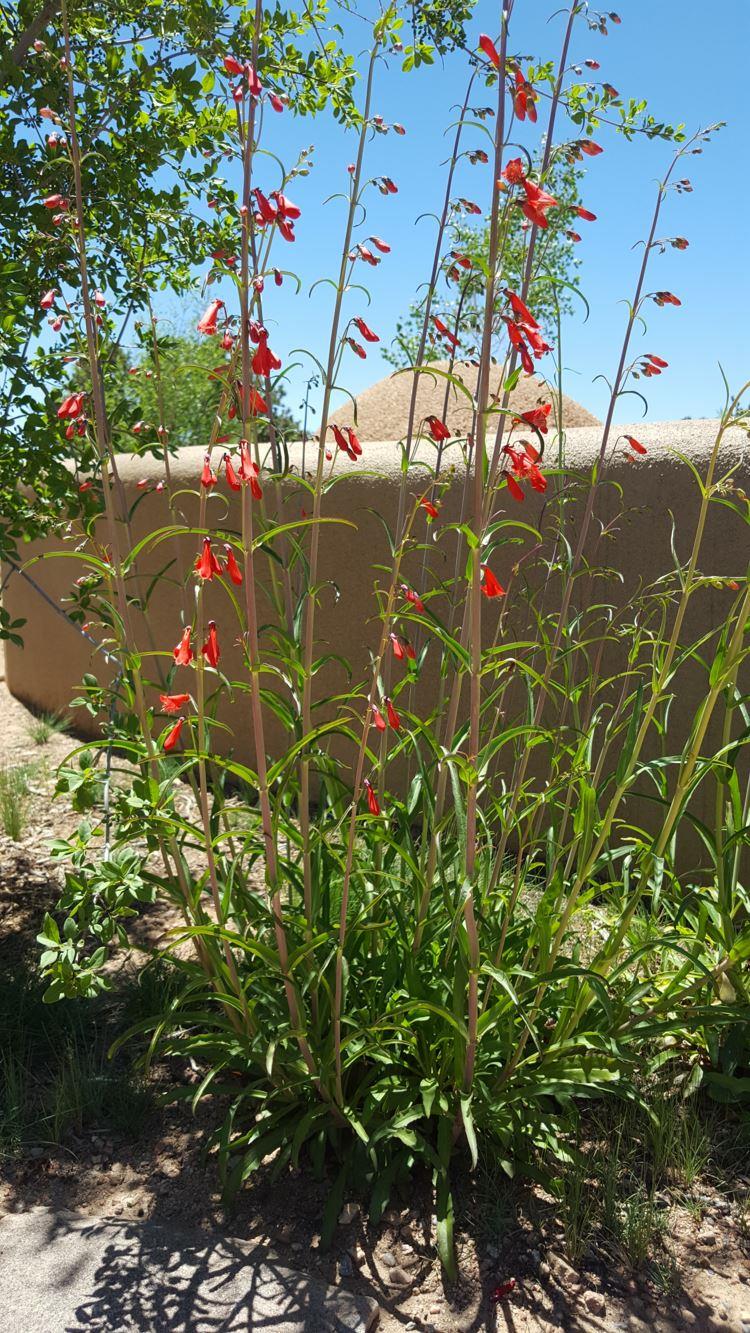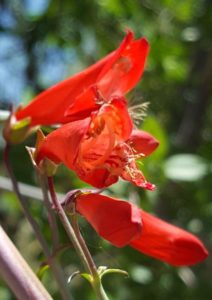Scientific name: Penstemon barbatus (Cav.) Roth
Suggested pronunciation: “PEN-stem-on” “bar-BAY-tus”
Family: Plantaginaceae (formerly Scrophulariaceae)
Common names: scarlet bugler, St. Joseph’s staff, beard lip penstemon, plantain, figwort, twizzle scarlet
Article by Jeanne Gozigian

Photo by Joy Mandelbaum
The Penstemon genus is plant species that has been moved from the family Scrophulariaceae to Plantaginaceae, just when we were used to remembering, pronouncing and spelling, the old one. Taxonomists like to keep us on our toes. The genus is endemic to (= native to only) North America and has the largest number of species, 243, of any endemic genera of the area. Many are beautiful and showy.
This particular species is a real beauty. The tall flowering stalks grow from a basal rosette and have narrow, dark green leaves. The blossoms form scarlet red, tubular corollae with lower lips and two flared wings. Their preferred habitats are mesas and mountains from Sonora in Mexico through Arizona, New Mexico, Texas. Utah and Colorado. They are native to the southwest United States.
I loved to see them appear first in June, on mountain hikes. They were immediately noticeable with their two-foot-tall spikes of brilliant blooms, often along roadways approaching trailheads. They thrive in sun and in partial shade so are seen everywhere. Blooming through October, they can be enjoyed for long periods of time. Their tubular forms are ideally suited to hummingbirds, butterflies, moths and other birds

Photo by Joy Mandelbaum
First named by Dr. John Mitchell (1711-1768), a Colonial American physician and botanist in 1748; alas, Mitchell was not credited because he published his naming before Linnaeus published Species Plantarum in 1753. The generic name comes from the Greek, “pen” meaning, almost, and “stamon” meaning, thread, referring to the slender, fifth, sterile stamen common to the beardtongue (Penstemon) family. Barbatus, from the Latin, means hairy or bearded.
Scarlet penstemon can be found at the Museum Hill Garden of the Santa Fe Botanical Garden. It is located at the Bridge Exit and the Overlook areas.
Penstemon barbatus can be a nice addition to your home garden as they require just low water use. Sow seeds in the fall or obtain live plants from nurseries specializing in native plants. Unfortunately, they are short-lived, so you may have to plant again to keep them in a designated place in your garden. If you collect seeds, they may have to be cold stratified to germinate. The tall stalks tend to flop, so may need support. Plant them behind shorter plants to maximize display.
Thanks to Janice Tucker and Helen Woody for reviewing this article.
Sources:
Harrison, Lorraine. Latin for Gardeners, The University of Chicago Press, 2012.
“Penstemon barbatus”. Native Plants Database. Lady Bird Johnson Wildflower Center. 23 Oct 2015. Web. 30 Dec 2019. Retrieved from: https://www.wildflower.org/plants/result.php?id_plant=PEBA2
“Penstemon Species, Beardlip Penstemon, Beard Tongue, Firecracker Penstemon, Red Penstemon”. Dave’s Garden. Web. 30 Jan 2020. Retrieved from: https:davesgarden.com/guides/pf/go55224
“Scarlet Bugler, Penstemon barbatus”. Southwest Yard and Garden Plant Advisor. New Mexico State University. Web. 30 Dec 2019. Retrieved from: https://desertblooms.nmsu.edu/plantadvisor/detail.php?plant_id=256
Schneider, Al. “Penstemon barbatus var. torreyi”. Southwest Colorado Wildflowers. Web. 30 Dec 2019. Retrieved from: http://www.swcoloradowildflowers.com/Pink%20Enlarged%20Photo%20Pages/penstemon%20barbatus%20and%20eatonii.htm


